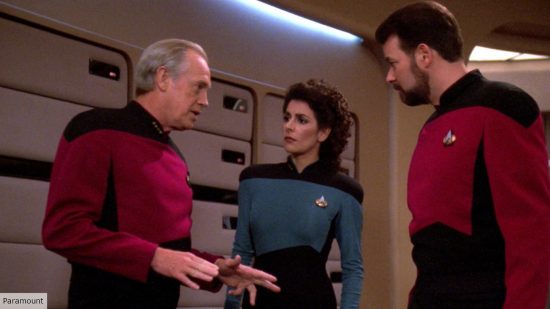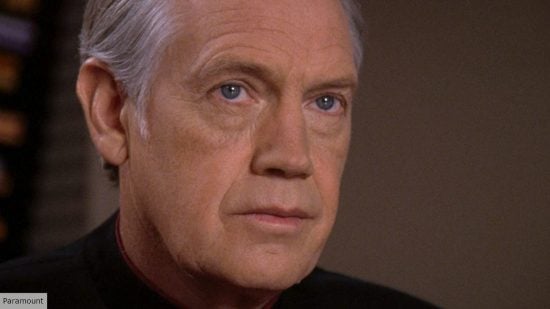Star Trek Picard season 3 doesn’t have many original ideas. In fact, that’s probably already giving it too much credit. This latest season of the Star Trek series is a stitched-together Frankenstein of ideas from the franchise’s past. It asks: what if you took the character dynamics from The Motion Picture, the setting of The Wrath of Khan, the villains from the Dominion War, the cast of TNG and mashed them all together?
Naturally, then, anything new stands out like a laughing Vulcan. The soaring score from composer Stephen Barton, the gorgeous design of the USS Titan-A, the ship’s young and eager crew. Except, even each of these is built on the foundation of the past. New musical compositions are grand but draw heavily from well-known themes and arrangements. The Titan-A is a refit of Riker’s own ex-ship. Its fresh-faced crew isn’t so fresh-faced after all.
Old fan-favourite and Star Trek Picard alum Seven of Nine is the first officer. Sidney LaForge, daughter of the great Geordi, takes the helm. The background cast of Star Trek characters on the ship (the Vulcan science officer, the Bajoran tactical officer, the Trill doctor) aren’t really characters at all, and they’re not intended to be. They’re placeholders to fill a space because a starship needs a crew, and I guess someone needs to take the conn.
Captain Shaw bucks the trend. Brilliantly portrayed by Todd Stashwick and pricklier than a porcupine, Shaw is neither someone we’ve seen before nor related to someone we’ve seen before. A certified win, then, for those of us who aren’t impressed simply by nostalgia or references.

Don’t get too excited, though, because Star Trek Picard season 3 just can’t help itself. Sisko’s backstory – anger at Picard fermented from his experience at Wolf 359 – is grafted onto him in place of anything original. And beyond that, the sci-fi series is absolutely desperate for Captain Shaw to become the new Captain Jellico.
The comparison was evident from the start. Captain Jellico, who assumed command of the Enterprise-D in the all-time great two-parter Chain of Command, is famous in Star Trek history for his no-nonsense, rigid approach to his job. He locked horns with the crew, and Riker especially, as he attempted to turn the Enterprise-D into a Star Trek starship which worked the way he wanted it to when he wanted it to.
He was magnetic because he so effectively made it clear that there can be more than one way to captain the Enterprise-D, more than one way to achieve results. Placed under extreme pressure, he was eventually forced to rely on Riker against his will. The parallels between Captain Jellico and Captain Shaw are clear then, but it’s their military style, most of all, that attracts the comparison.

That comparison isn’t accidental. In Captain Shaw’s introduction scene he has a meal with Riker and Picard. Speaking to Riker, the ex-captain of his ship, Shaw talks about, “All the bebop I had to purge from the system when I took the chair. It speaks to your free-wheeling, loosey-goosey, Kentucky mash kind of style.” Riker replies, “Not a fan of jazz?” and Captain Shaw says “No I am not. I like structure. I like meter and keeping tempo and time.”
For anyone who’s watched an unhealthy amount of Star Trek, or for any particular Captain Jellico stans out there, this will have immediately struck a chord.
It explicitly, intentionally, wants to remind you of Captain Jellico’s scene with Riker in Chain of Command part 2, when the captain enters Riker’s quarters to ask him to pilot a shuttle. As Jellico paces around the quarters, he observes Riker’s famous trombone and says, “[You’re a] musician? Classical, contemporary?” Riker responds, correcting him: “Jazz.” It leaves Captain Jellico taken aback and uncomfortable.
What do we learn from Captain Jellico’s scene here? He assumed that Riker’s instrument is used to play classical music, music with structure and organised complexity because that fits within his worldview. Riker’s response that he plays jazz (free-flowing and spontaneous) highlights their inherent differences in outlook and therefore approach to command.

It is, for all intents and purposes, the same scene. The two ‘antagonist’ captains emphasise their differences to Riker through their attitudes to music. There’s one key distinction, however. Captain Jellico’s scene allows the audience to draw out their own conclusion, Captain Shaw’s scene simply lays it all out for you: you have to do no work. Whoever needed subtext, anyway?
Captain Shaw’s ‘Captain Jellico’ scene is indicative of a lack of subtlety found throughout the rest of Star Trek Picard season 3. When the show wants to explore the notion of legacy it throws up the idea that Jean-Luc Picard has a secret son. When it wants to be about how the passage of time corrodes relationships, it presents us with the broken bonds between Picard and Crusher, and Riker and Troi. Not exactly deep or nuanced stuff, really.
Star Trek Picard season 3 engages with its own ideas on a strictly surface level as if it fears losing its audience through over-complexity. Well, there’s no chance of that. It wants to create a new Captain Jellico, but the result is an imitation stripped of the subtlety and depth that made the character so captivating in the first place.
For more on Star Trek Picard, check out our Star Trek Picard season 3 review. Or stay up to date with the latest episode with our Star Trek Picard season 3 episode 4 recap. Alternatively, find out what we know about the Strange New Worlds season 2 release date, and learn why we think Star Trek Picard season 3 is more like The Motion Picture than The Wrath of Khan.
